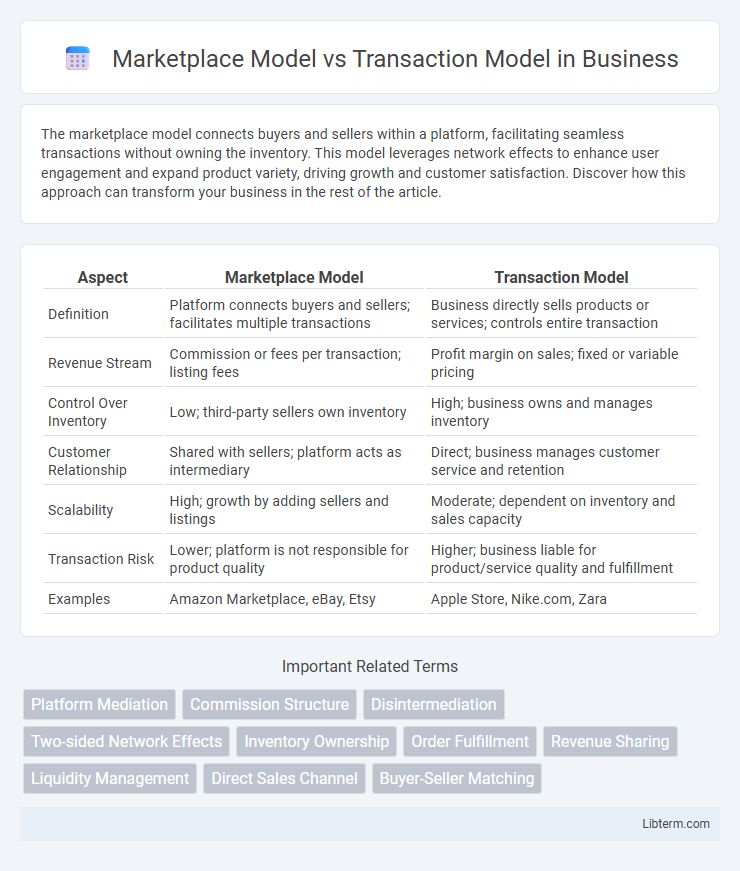The marketplace model connects buyers and sellers within a platform, facilitating seamless transactions without owning the inventory. This model leverages network effects to enhance user engagement and expand product variety, driving growth and customer satisfaction. Discover how this approach can transform your business in the rest of the article.
Table of Comparison
| Aspect | Marketplace Model | Transaction Model |
|---|---|---|
| Definition | Platform connects buyers and sellers; facilitates multiple transactions | Business directly sells products or services; controls entire transaction |
| Revenue Stream | Commission or fees per transaction; listing fees | Profit margin on sales; fixed or variable pricing |
| Control Over Inventory | Low; third-party sellers own inventory | High; business owns and manages inventory |
| Customer Relationship | Shared with sellers; platform acts as intermediary | Direct; business manages customer service and retention |
| Scalability | High; growth by adding sellers and listings | Moderate; dependent on inventory and sales capacity |
| Transaction Risk | Lower; platform is not responsible for product quality | Higher; business liable for product/service quality and fulfillment |
| Examples | Amazon Marketplace, eBay, Etsy | Apple Store, Nike.com, Zara |
Introduction to Marketplace and Transaction Models
The Marketplace Model facilitates exchanges between multiple buyers and sellers within a centralized platform, enabling diverse product offerings and competitive pricing. The Transaction Model centers on direct sales or service transactions, where revenue is generated from each individual sale or service rendered. Understanding these models clarifies how digital and traditional businesses structure their sales processes and revenue streams.
Key Definitions: Marketplace vs Transaction Model
The marketplace model is a platform where buyers and sellers interact to exchange goods or services, facilitating multiple transactions without owning the inventory. The transaction model centers on individual exchanges, emphasizing the specific sale or purchase event, often involving direct ownership transfer. Key distinctions include the broader connectivity and ongoing interactions in marketplaces versus the singular focus on each sale within transaction models.
Core Differences Between the Two Models
The Marketplace Model centers on facilitating exchanges between buyers and sellers by providing a platform for listing, searching, and matching products or services, typically generating revenue through commissions or listing fees. In contrast, the Transaction Model emphasizes direct control over the sales process, often owning or managing inventory, and profits primarily through fixed pricing and margin on each transaction. Core differences include the level of inventory ownership, control over pricing, and revenue generation mechanisms, with Marketplace Models promoting peer-to-peer interaction, while Transaction Models focus on end-to-end sales management.
Advantages of the Marketplace Model
The Marketplace Model offers scalability by connecting multiple buyers and sellers on a single platform, enhancing variety and competition which drives better pricing and choices for consumers. It reduces operational costs for the platform owner since inventory and fulfillment are managed by sellers, allowing faster market entry and lower capital expenditure. This model also enables diversified revenue streams through commissions, advertising, and premium services, increasing overall profitability and business resilience.
Benefits of the Transaction Model
The Transaction Model provides clear revenue streams by charging fees per sale, enhancing cash flow predictability for businesses. This model drives user engagement through seamless payment processing and secure fund transfers, which build trust and repeat usage. Scalability is facilitated as the platform grows, allowing increased transaction volume without proportionally higher operational costs.
Revenue Generation Strategies
The Marketplace Model generates revenue primarily through commission fees on each transaction facilitated between buyers and sellers, often supplemented by listing fees and premium services. In contrast, the Transaction Model relies on direct sales where revenue comes from the margin between purchase and resale prices, sometimes enhanced by volume discounts or subscription plans. Both models leverage dynamic pricing, user data analytics, and targeted advertising to optimize income streams and maximize profitability.
User Experience and Trust Factors
The Marketplace Model enhances user experience by providing diverse options and streamlined transaction flows within a trusted platform that vets sellers and guarantees secure payments. The Transaction Model emphasizes simplicity and speed, often minimizing intermediary involvement, which can reduce friction but may compromise transparency and user trust. Trust factors in the Marketplace Model benefit from comprehensive review systems and dispute resolution mechanisms, whereas Transaction Models rely heavily on individual reputation and direct interactions to build confidence.
Scalability and Operational Challenges
Marketplace models scale efficiently by leveraging network effects, connecting multiple buyers and sellers without holding inventory, which reduces operational burdens. Transaction models face scalability challenges as they require managing each transaction end-to-end, including inventory, fulfillment, and customer service, increasing operational complexity. Consequently, marketplaces often experience faster growth and lower incremental costs compared to transaction-based businesses.
Industry Examples and Case Studies
The Marketplace Model enables companies like eBay and Airbnb to connect buyers and sellers, facilitating peer-to-peer transactions while earning revenue through commissions or listing fees. In contrast, the Transaction Model, used by firms such as PayPal and Stripe, focuses on processing payments and securing transactional data, charging fees per transaction processed. Industry case studies show that marketplaces thrive in sectors like travel and retail by leveraging network effects, whereas transaction models excel in fintech by ensuring seamless and secure payment experiences.
Choosing the Right Model for Your Business
Selecting the appropriate business model between Marketplace and Transaction hinges on your company's core objectives and customer engagement strategy. The Marketplace Model facilitates multi-vendor interactions, promoting scalability and diverse offerings, ideal for businesses targeting broad audiences and network effects. Alternatively, the Transaction Model centers on direct sales and streamlined operations, best suited for companies prioritizing control over inventory and customer experience.
Marketplace Model Infographic

 libterm.com
libterm.com